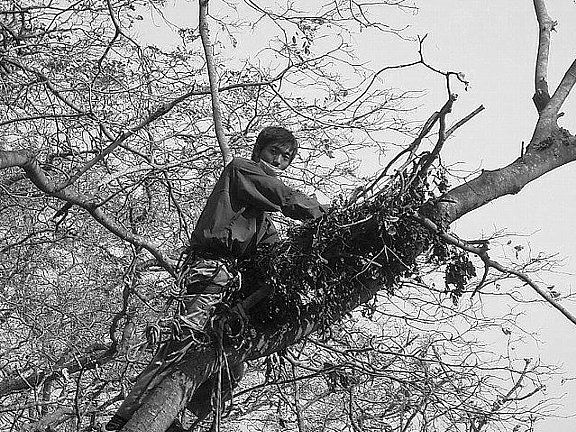|
<NEWS>
DNA sampling and DNA analysis of chimpanzees at Mahale
Eiji Inoue
INTRODUCTION Improvements in genetic techniques have enabled us to study DNA in wild animals. Until recently, it has been difficult to determine the genetic background of wild animals without capturing them. In many cases, capture disturbs their lives. Accordingly, it is better to use non-invasive methods for analyzing DNA. Genetic research on wild chimpanzees has mostly been conducted by the use of fecal samples1, 2. Shed or scratched hairs,3, 4 food wadge,5 and urine6 have been also used as DNA samples of primates. The chimpanzees of the Mahale Mountains National Park have been studied for a long time. Within one well-habituated group, the M group, we know the profiles of many chimpanzees, including age, year of immigration, and motherís name. Consequently, this group is highly suitable for genetic studies. Furthermore, many other groups exist around the Mahale area. If we collect DNA samples from a wide area, the genetic structure of wild chimpanzees will be clarified.
I have collected many materials as DNA samples at Mahale. In this report, I show samples and sampling methods and then present my perspectives on the analyses.
When we followed chimpanzees of the M group, we sampled what probably contains cells. We collected feces and urine mainly because it was not difficult to get them while following the chimpanzees. I occasionally observed freshly dropped blood on leaves. When individuals were observed to scratch their body and shed their hair, the hairs were collected. Food wadges, which chimpanzees spat out after chewing food, were also collected. Sometimes they licked branches and their saliva remained. Saliva was collected because it probably includes buccal cells. Male chimpanzees discard sperm remaining on their penis after copulation. The sperm samples are probably contaminated with cells from other individuals, but we still collected them. When mothers brought their dead babies, I obtained some fluids from the carcasses. I also collected tissue samples from carcasses of infants after their mothers left them.
It is difficult to observe the chimpanzees of other groups, but we could find the beds of these chimpanzees. I collected their hairs that remained on the beds and feces near or on the beds (Figure 1).

Figure 1. Sampling on the bed of chimpanzee SAMPLING METHODS Some of the fecal samples were dried up with silica. Other samples of feces, blood, food wadges, saliva and fluid from carcasses were put into a 0.9% NaCl and 1 mM EDTA Na3 solution, to which ethanol was added up to 70% vol. Ethanol was also added to urine up to 70% vol. Hair samples were put into the 70% ethanol environment or kept in a dry condition. Sperm and tissues were also kept in the 70% ethanol environment. PERSPECTIVES Genetic research on chimpanzees at Mahale has already been conducted by Linda Vigilant of the Max Planck Institute, Germany. Her team analyzed 8 loci of microsatellite DNA in many M group chimpanzees. They extracted DNA from dried feces and succeeded in determining the genotype of many samples. I will cooperate with them and analyze the microsatellite DNA of all M group members as they did. From the genotype of the M group chimpanzees, we can show the paternity and relatedness of individuals.
Shed hair samples do not always provide enough DNA7. If we can get sufficient DNA from shed hairs, we will be able to clarify the genetic structure of wild chimpanzees by microsatellite DNA on autosome, Y chromosome and mitochondrial DNA. Through such analysis, this study will provide important information for conservation of wild chimpanzees.
Back to Contents |